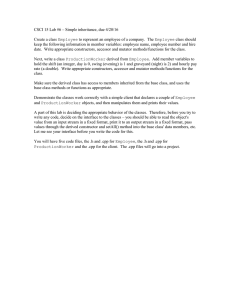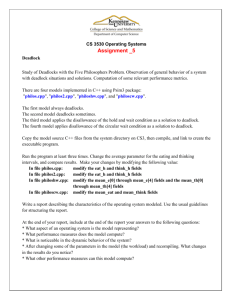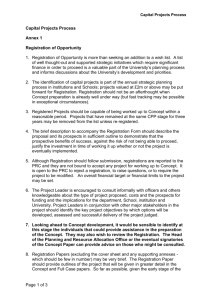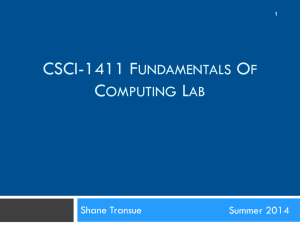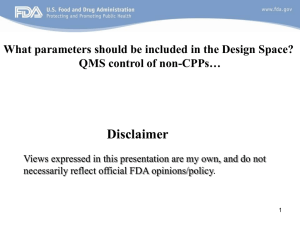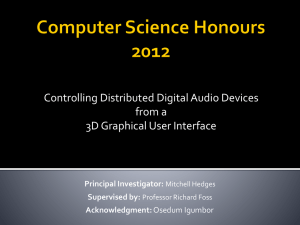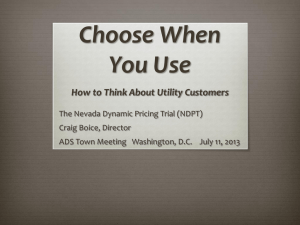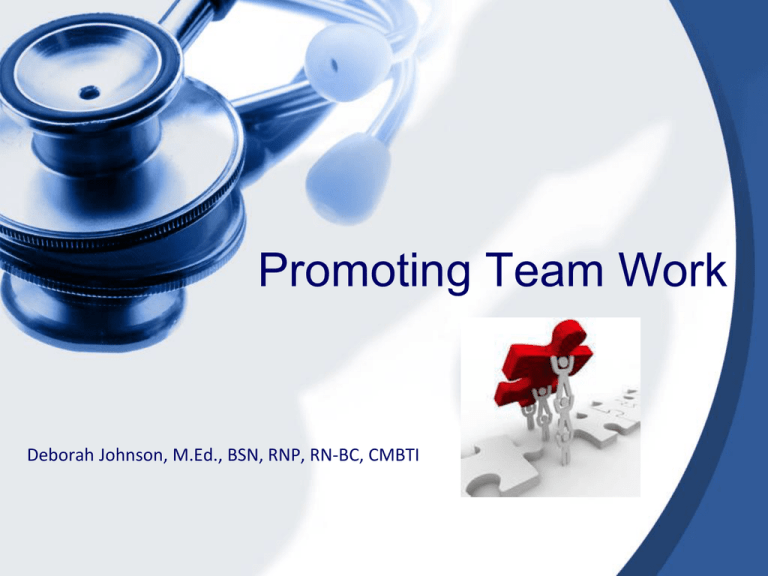
Promoting Team Work
Deborah Johnson, M.Ed., BSN, RNP, RN-BC, CMBTI
Objectives
Identify strategies that will
create and sustain
long distance team relationships
“Teamwork is the ability to work
together toward a common vision
The ability to direct individual
accomplishments toward
organizational objectives.
It is the fuel that allows common
people to obtain uncommon results.”
Andrew Carnegie
Teams and Dialogue
How effective are you in:
• Maintaining dialogue from a distance?
• Keeping a team focus for patient care?
• Working through disagreements or conflict?
Cultural &
Work/Life Values
Trust
Individual Preferences
Personality Types
• Why people “act that way”
• Strengths related to personality type
• Used to solve problems, perform tasks
• Communication, trust issues usually sign
of misunderstanding of personalities
What do you know about
Your Team Members?
Characteristics
Successful Behavior
• Communication
Trust
• Openness
Fairness
• Engagement
Collaboration
• Responsibility
Accountability
• Problem Solving
Decision making
Contributions
• What strengths do you bring?
• What strengths do you appreciate and
value about your other team members?
Functional Teams
• Trust
• Conflict Resolution
• Commitment
• Accountability
• Attention to Results
Team Barriers
What are Yours?
Conflict Is…
• NORMAL
• INEVITABLE
• NECESSARY
Do you make any of these five common
(and costly) mistakes?
• #1: Underestimate your own authority, ability and
strengths.
• #2: Assume you know what the opposition wants.
• #3: Overestimate your opponent’s knowledge of your
weaknesses.
• #4: Become intimidated by your opponent’s prestige,
rank, title or educational accomplishments.
• #5: Overly influenced by traditions, precedents,
statistics, forecasts, or cultural icons and taboos.
http://www.pon.harvard.edu/free-reports/thank-you/?n=1&freemium_id=7694
Conflict Mode
• Do you
o Know what style you typically use or lean
toward?
o Recognize the styles of others?
o Select approaches that minimize issues?
o Adapt your style to meet the needs of the
situation and/or person?
Assertiveness
Understanding the Conflict Modes
Two basic aspects of all
Conflict-handling modes
Cooperativeness
Your Conflict
Mode =
Skill + Situation
Copyright © 1996 by Xicom, Incorporated. Revised binder © 2003 by CPP, Inc. Xicom, Incorporated, is a
subsidiary of CPP, Inc.
Permission is hereby granted to reproduce this overhead for workshop use only. Duplication for any other
use, including resale, is a violation of copyright law.
The Five Conflict-Handling Modes
Copyright © 1996 by Xicom, Incorporated. Revised binder ©
2003 by CPP, Inc. Xicom, Incorporated, is a subsidiary of
CPP, Inc. Permission is hereby granted to reproduce this
overhead for workshop use only. Duplication for any other
use, including resale, is a violation of copyright law.
From Thomas-Kilmann Conflict Mode Instrument by K.
W. Thomas and R. H. Kilmann, 1974, 2000. Mountain
View, CA: Xicom, Incorporated, subsidiary of CPP, Inc.
Copyright 1974, 2000 by CPP, Inc. Used with
permission.
Avoidance
High
Importance
R
E
L
A
T
I
O
N
S
H
I
P
Low
Importance
GOAL
High
Importance
Accommodate
ACCOMODATE
High relationship
Low content
AVOIDANCE
Low relationship
Low content
Compete
ACCOMODATE
High relationship
Low content
COMPETE
Low relationship
High content
Compromise
Collaboration
COLLABORATION
High relationship
High content
COMPETE
Low relationship
High content
Speak in the Positive
Words and
Tone of Voice
What phrases
do you use?
Negative
Phrase
Positive
Phrase
I don’t know
I’ll find out
That’s not my job
I will find someone
who can help you
I’m busy right now
I’ll be with you in a
minute
Why don’t you give
me a call back in a
few minutes?
May I call you back?
Why did you…
(implying blame)
Tell me what you
understand
We can’t do that
Let’s see what we
can do
That’s not my fault
I will get this taken
care of
Self Reflection
• Honestly identify barriers, fears,
emotions, perceptions, assumptions
• Recognize inner conflict related to
beliefs, values, morals that lead to
conflict, ethical dilemmas
• Express emotions and thoughts using
critical thinking and emotional
intelligence skills
Trouble Spots
• Determine triggers that result in
dis-ease or conflict
• Character assassination
o Internal - thoughts, images
o External - nonverbal, verbal
• Strife – brew and fester – explode
Create the Culture
• Separate people from the problem
• Focus on interests, not positions
• Develop multiple options
• Use objective criteria and fair processes
• Consider best alternatives
Create the Culture
• Create safety valves
o Establish ground rules, norms, code of
conduct
o Define expectations, purpose, goals,
resources
o Work processes, problem solving,
decision making
• Define, discuss, share, document,
support, reinforce
Great opportunities disguised
as impossible situations
Engaging the Team
• Does not happen naturally
• Time to know each other
• Mission understood
• Clear objectives, tasks, expectations
• Established boundaries
• Timely information
• Evaluation and follow up
Benchmarks
• Self check
• Surveys
• Onsite observations
• Team diagnostic checklist
References
CPP, Inc. Thomas-Kilmann Conflict Mode Instrument.
Group Conflict Mode Score: An Application of the Thomas-Kilmann Conflict Mode Instrument
Copyright 1996, 2003, 2012 by CPP, Inc. All rights reserved. Permission is hereby granted to
reproduce this product for workshop use. Duplication for any other use, including resale, is a violation
of copyright law. The TKI and CPP logos are trademarks or registered trademarks of CPP, Inc., in the
United States and other countries.
Website for score sheet: https://www.cpp.com/en/tkiitems.aspx?ic=4800EF3
Lencioni, Patrick M (2002). The Five Dysfunctions of a
Team, A Leadership Fable. San Francisco: Jossey-Bass.

